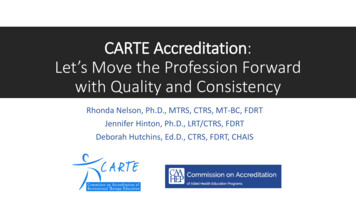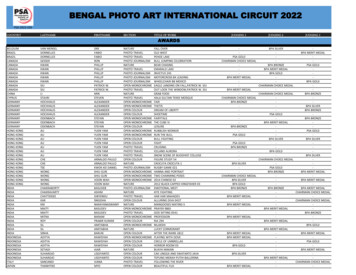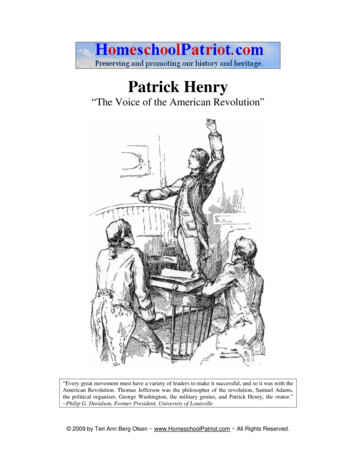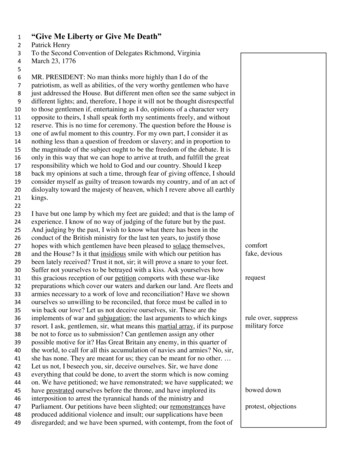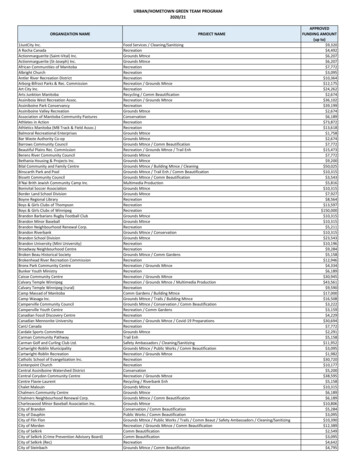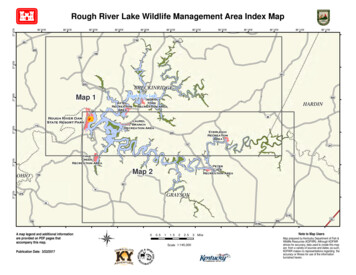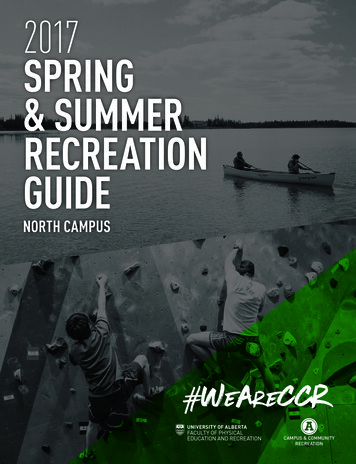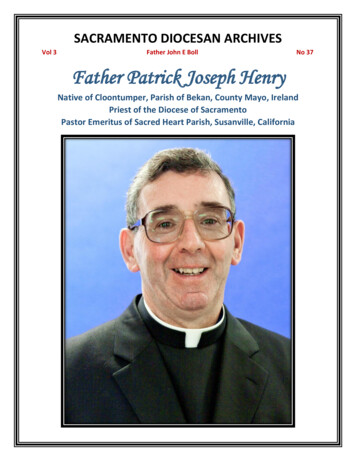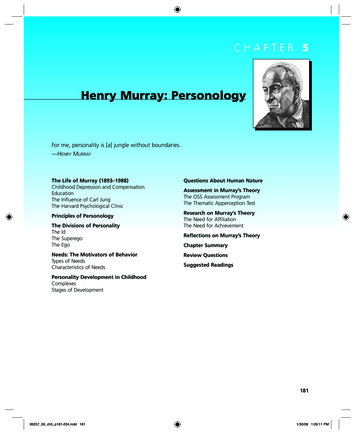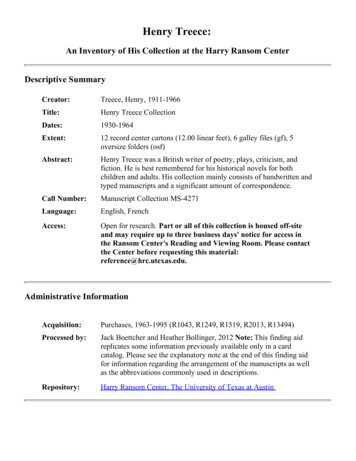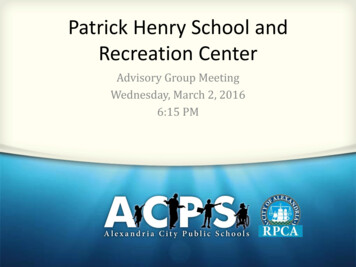
Transcription
Patrick Henry School andRecreation CenterAdvisory Group MeetingWednesday, March 2, 20166:15 PMwww.acps.k12.va.us
Agenda Meeting Guidelines (1 min)Meeting Goals (2 min)Project Update Traffic Study (5 min)Design Review Process (5 min)Design Considerations (5 min)Initial Site Plan Options (15 min)Board Review / Discussion (30 min)March 16th Community Meeting (20 min)Next Steps (5 min)www.acps.k12.va.us2
Meeting Guidelines Treat Everyone with Respect and CourtesyDo Your Homework – Be Prepared and Be Familiarwith the DocketExpress Your Ideas and Opinions in an Open andHelpful MannerBe Respectful of Others’ Time by Being Clear andConcise in Your Comments and/or QuestionsDemonstrate Honesty and Integrity in YourComments and ActionsTaken from City of Alexandria ‘Guidelines for Civic Discourse’www.acps.k12.va.us3
Meeting Guidelines Focus on the Issues Before the Decision Making Body– Avoid Personalizing IssuesListen and Let Others Express their Ideas andOpinionsIf a Decision is Made with which You Do Not Concur,Agree to Disagree and/or Use Appropriate Means ofCivil and Civic recourse, and Move OnTaken from City of Alexandria ‘Guidelines for Civic Discourse’www.acps.k12.va.us4
Meeting Goals Provide update on project team ongoing effortsReceive high-level feedback from Advisory Group on initialthree site optionsDiscuss process for engaging broader community at March16th meetingwww.acps.k12.va.us5
Project Update – Traffic Study Preliminary in nature Examined Taney-and-Latham access and Taney-only access Studies typically occur during site design processProject team advanced study to examine community concernsduring feasibilityStudy will be finalized once a site option is selected foradvancementBoth situations maintained acceptable levels of serviceEntries off both streets would ease onsite traffic (pickup, drop-off)Busing shall have separate access from cars for safetyFire department requiring an Emergency Vehicle Easement(EVE) off Latham to access all sides of new buildingwww.acps.k12.va.us6
Project Update – Design Review Iterative ProcessOngoing Stakeholder Engagement Ongoing Design Review Team Efforts (for March 16 meeting) Design Review Team (ACPS and City staff)Advisory GroupBroader CommunityRegulatory Agency Reviews (Concept I DSUP)ACPS School BoardMeeting program requirementsCost ImpactsSchedule impactsDesigns will evolve during stakeholder reviewwww.acps.k12.va.us7
Project Update – Design Reviewwww.acps.k12.va.us8
Initial Design Considerations – Taking Shape Fulfill Site Specific Program DocumentSite Traffic Flows and Parking (Buses, Cars, Bikes, Pedestrians)LEED and Sustainability / Stormwater ManagementConsideration of Neighborhood Context (Scale, Setbacks)Safe Construction Around Operating FacilitiesBe Constructible Within Capital Project BudgetMaximize natural open space areas on the siteAttention to performing arts spaceProper focus on both the school and the recreation centerRemembering the big picture – designing a facility which thecommunity is proud of and uses oftenwww.acps.k12.va.us9
Discussion Moseley Architects to review current design optionsAfter presentation Advisory Group members shall approachthe presentation boards to ask questions of team membersAdvisory Group members will return to panel seats for 30minutes of additional discussion on: Initial thoughts (30 minutes)Engagement with Community on March 16th (20 minutes)www.acps.k12.va.us10
www.acps.k12.va.us11
www.acps.k12.va.us12
www.acps.k12.va.us13
www.acps.k12.va.us14
www.acps.k12.va.us15
www.acps.k12.va.us16
www.acps.k12.va.us17
March 16th Community Meeting Meeting Goals and Structure Receive feedback from attendees on: Which design considerations are most important to them How does each proposed site design accommodate thoseconsiderationsPlease share with your constituents! Send as much feedback as possible tophproject@acps.k12.va.us by Friday, March 11th for the projectteam to incorporate into March 16th meetingwww.acps.k12.va.us18
Proposed Advisory Group and CommunityMeeting Schedulewww.acps.k12.va.us19
Next Steps Ongoing stakeholder reviews of current site designoptions Community meeting on March 16 Construction Manager procurementwww.acps.k12.va.us20
Additional information about the project can be found ww.acps.k12.va.us21
EXECUTIVE SUMMARYPATRICK HENRY SCHOOL AND RECREATION CENTERPRELIMINARY TRAFFIC IMPACT AND PARKING STUDYDRWells Associates (W A) has prepared a preliminary traffic impact and parking study for thePatrick Henry School and Recreation Center, located in Alexandria, Virginia. In a Joint Project theCity of Alexandria, the Department of Recreation, Parks and Cultural Activities (RPCA), AlexandriaCity Public Schools (ACPS) plan to replace and expand the existing elementary school with acapacity of 670 students and the 8,779 square foot (S.F.) recreation center with a newelementary/middle school with a capacity of 900 students and a 17,000 S.F. recreation center.Vehicular access is provided at the eastern and western ends of the site frontage along TaneyAvenue. This study evaluates a site plan approach created by a feasibility study commissionedjointly by ACPS, RPCA, and the City, which retains the eastern access on Taney Avenue andConstructs a new driveway north of the site on N. Latham Avenue. An alternative approach was alsoconsidered whereby all vehicular traffic would access the site only off Taney Avenue. A new busdrop-off/pick-up lane would be provided on Taney Avenue. The existing western access would beeliminated and student drop-off/pick-up activity occurring on Taney Avenue would be restricted.The project is planned to be complete by 2018.AFA total of 16 intersections were included in the study that evaluated the AM, midday (school), andPM peak hours. Based on data collected by W A, under existing 2015 conditions, all signalizedstudy intersections currently operate at acceptable levels of service (LOS “D” or better), except forthe intersections of Taney Avenue and Richenbacher Avenue on N. Van Dorn Street, which operateat LOS “E” during the AM and PM peak hours, respectively. All stop controlled study intersectionscurrently operate at acceptable levels of service for the AM, midday, and PM peak hours. Based onfield site observations, traffic operations around the school are somewhat congested but adequateduring the morning and afternoon school peak hours. The activity adjacent to the site iscompressed into a 15 to 30-minute period when students arrive or depart from the school, and arefacilitated by school staff that manages vehicle and pedestrian movements during these periods.Less congested conditions occur during the PM peak hour when the school day is complete butsome activity occurs at the recreation center on the northeast corner of the site.TIn 2018 without the proposed development, but assuming regional growth and other pipelinedevelopments, the majority of signalized study intersections and all stop controlled intersectionswould continue to operate at overall acceptable levels of service (LOS “D” or better) during the AM,midday, and PM peak hours, consistent with existing conditions. Some individual movements andapproaches would operate near or beyond capacity during these peak periods.The proposed school expansion from 637 existing students to 900 students and the recreationcenter expansion from 8,779 S.F. to 17,000 S.F. is estimated to generate 151 net new AM peak hourtrips, 106 midday net new peak hour trips, 64 PM net new peak hour trips, and 677 net new daily(24-hour) trips upon completion and full occupancy by 2018. These additional vehicles were addedto the road network to evaluate the impact of the planned redevelopment.The results of the future conditions with the development indicate that the majority of signalizedstudy intersections and all stop controlled intersections would continue to operate at overallacceptable levels of service (LOS “D” or better) during the AM, midday, and PM peak hours, withoutsignificant increases in overall delay at most locations. Increases in delay would be primarilyrealized on Taney Avenue intersections immediately adjacent to the school, but would beadequately accommodated at these locations. Thus, no off-site improvements, such as traffic signal1 1
modifications or turn lane extensions, are recommended at off-site intersections in conjunctionwith the redevelopment of the Patrick Henry School and Recreation Center. In addition, thedriveways planned to serve the site on both Taney Avenue and N. Latham Street would adequatelyaccommodate the additional site-generated vehicle trips, and operate at acceptable levels of serviceduring the study periods.An alternative access scheme that assumes access is provided from only the east driveway on TaneyAvenue indicates that while acceptable levels of service could be maintained, the management ofon-site queuing is critical primarily during the midday peak hour. Thus, the design that includesthe N. Latham Street driveway provides options for students to be dropped-off and picked-up onboth sides of the building and would better distribute traffic to the road network and better manageon-site queues. It is noted that the on-site circulation and parking will be refined as the site plansare finalized.DRBased on the existing and forecasted queues, under either option, it is recommended that the schoolincrease bus ridership in order to reduce the number of students arriving by private vehicle and onsite queuing. This would improve overall operations, reduce driver frustration, and discouragestudents being dropped-off along neighborhood streets. It is also assumed that the current trafficcontrol personnel would be maintained and augmented as needed with the redevelopment tofacilitate vehicular and pedestrian/bicycle traffic and manage on-site queues.AFThe existing parking supply of approximately 71 spaces exceeds City Code standards that are basedon the student capacity of the school and square footage of the recreation center. The selecteddesign option would provide approximately 140 spaces and would continue to exceed coderequirements. The on-site parking supply will be finalized during the site plan development stage.The field survey of parking occupancy indicates that there are a number of on-street parking spacesavailable throughout the morning, afternoon, evening, and weekend hours under existingconditions in close proximity to the site. A separate and more detailed parking study for the schooland recreation center will be provided under a separate cover.Based on the size of the proposed development, this project is classified as Tier 3, and will berequired to create a stand-alone Transportation Management Plan (TMP). This plan will bedeveloped by Alexandria City Public Schools in coordination with City staff in order to encouragenon-auto use and reduce peak hour traffic and parking demands and impacts.TThe redevelopment of Patrick Henry School and Recreation Center will revitalize the building andimprove services for the surrounding community. The project would continue to benefit from amature, connected street network that encourages non-auto modes, students walking to school, andminimizes traffic and parking impacts on the surrounding road network and neighborhood.Preliminary conversations with the Alexandria City Fire Marshall have indicated that it will be anecessity to include an Emergency Vehicle Easement (EVE) off of N. Latham in order for fire trucksto access all sides of the building in the event of an emergency. All analyses presented in thisdocument are preliminary. The traffic and parking study will be further refined based oncomments and discussions with the project team and will be finalized for submission to the public.O:\PROJECTS\6500-7000\6685 PATRICK HENRY SCHOOL TIA AND PARKING\DOCUMENTS\PATRICK HENRY SCHOOL AND RECREATION CENTER EXECUTIVE SUMMARY (W A2.19.16).DOCX2 2
Patrick Henry School and Recreation Center Advisory Group Meeting Wednesday, March 2, 2016 6:15 PM . www.acps.k12.va.us 2 Agenda Meeting Guidelines (1 min) Meeting Goals (2 min) Project Update Traffic Study (5 min) Design Review Process (5 min)
